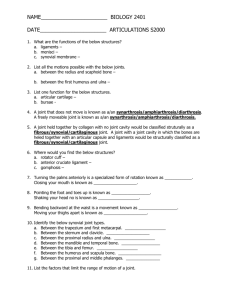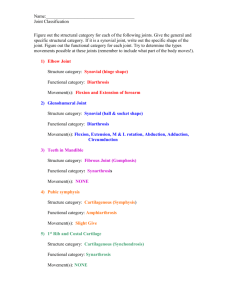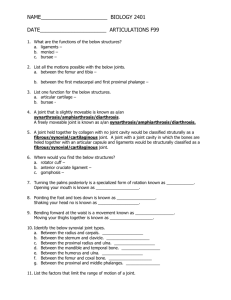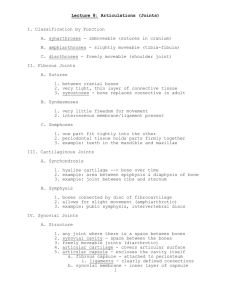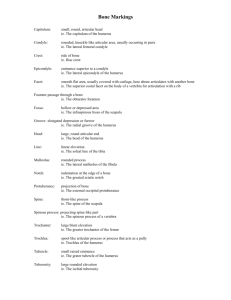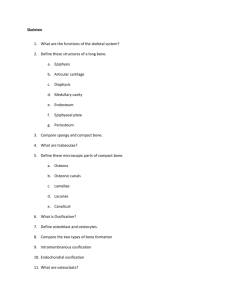Joints of the Body ARTICULATIONS OF BONES Structural
advertisement
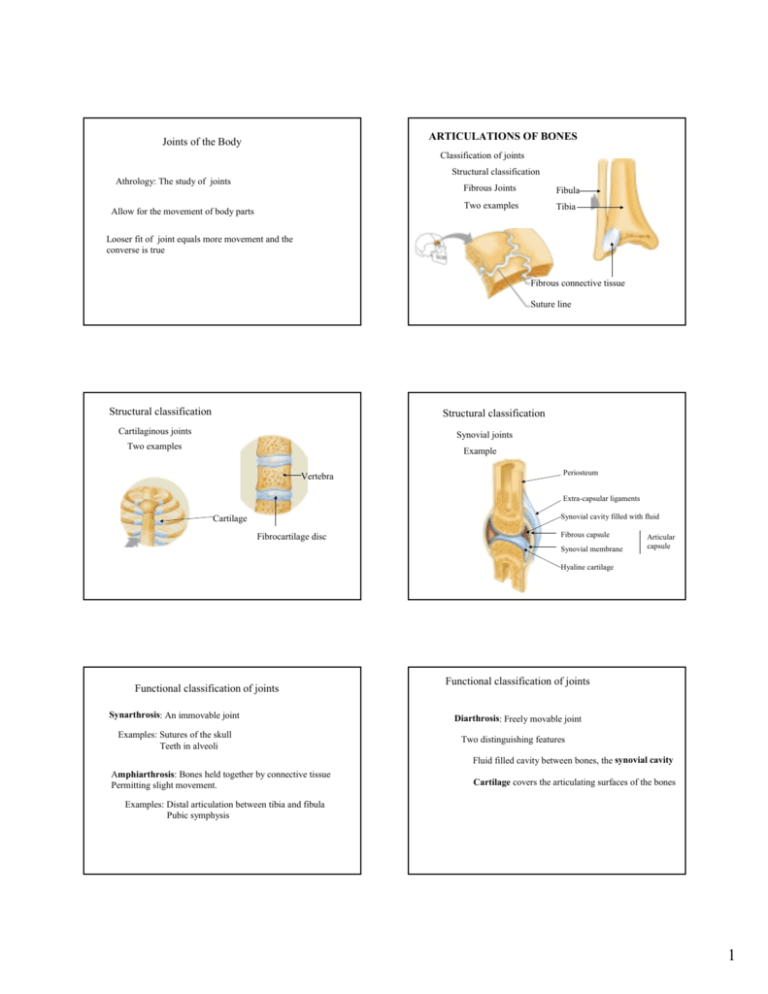
ARTICULATIONS OF BONES Joints of the Body Classification of joints Structural classification Athrology: The study of joints Allow for the movement of body parts Fibrous Joints Fibula Two examples Tibia Looser fit of joint equals more movement and the converse is true Fibrous connective tissue Suture line Structural classification Structural classification Cartilaginous joints Synovial joints Two examples Example Vertebra Periosteum Extra-capsular ligaments Synovial cavity filled with fluid Cartilage Fibrocartilage disc Fibrous capsule Synovial membrane Articular capsule Hyaline cartilage Functional classification of joints Synarthrosis: An immovable joint Examples: Sutures of the skull Teeth in alveoli Functional classification of joints Diarthrosis: Freely movable joint Two distinguishing features Fluid filled cavity between bones, the synovial cavity Amphiarthrosis: Bones held together by connective tissue Permitting slight movement. Cartilage covers the articulating surfaces of the bones Examples: Distal articulation between tibia and fibula Pubic symphysis 1 Structural of Diarthrosis Movement of diarthrosis Factors that limit movement of diarthrosis Bone structure Periosteum Hinge joint (elbow) Ball and socket (hip) Extra-capsular ligaments Synovial cavity filled with fluid Joint ligaments Fibrous capsule Synovial membrane Articular capsule Hyaline cartilage Degree of tension on ligaments Hormones Pubic symphysis; effects of relaxin Types of diarthrosis Gliding joint (plane joint) Characterized by flat articulating surfaces Articulation of vertebra with other Types of diarthrosis Hinge joint Characterized by movement in one plane where convex Surface of one bone fits into concave surface of second bone Bones of ankle and wrist Movements permitted: Flexion Extension Types of diarthrosis Pivot joint Permits rotational movemnet Round surface of one bone articulating with ring or Concave surface of second bone Atlas and axis Types of diarthrosis Condyliod joint Oval condyle of one bone fits into elliptical cavity of second bone Permits movement in two planes flexion/extension abduction/adduction Radius and ulna 2 Types of diarthrosis Types of diarthrosis Saddle joint Ball and socket Saddle shaped articular surface of one bone fits into U-shaped surface of second bone Permits movement in three planes Flexion/extension Joint between trapezius and metacarpal of thumb Abduction/adduction Rotation/circumduction Permits opposition Of thumb Shoulder Hip Shoulder joint Shoulder joint Numerous ligaments and tendons Joint with very free movement Juxtaposition of the scapula and humerus Tendons of five muscle and five ligaments – all join humerus to scapula Rotator cuff muscles Acromoin Coracoid process Articular capsule Supraspinatus Infraspinatus Glenoid cavity Teres Minor Subscapularis Scapula Knee joint Rotator cuff injury Tendon of supraspinatus vulnerable to injury as it runs between head of humerus and acrominon Acromion Largest joint in body Three articulating surfaces Two tibiofemoral Patellofemoral Head of humerus Numerous ligaments and tendons Secure joint Extracapsular ligaments Patellar Tibial (medial) collateral Fibular (lateral) collateral 3 Knee joint Intracapsular ligaments Posterior cruciate Ant. lat condyle of tibia to med. condyle of femur Anterior cruciate Ant. med condyle tibia to post of lat condyle of femur Articular discs Lateral meniscus Medial meniscus 4
